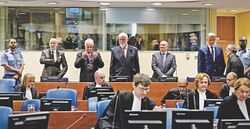Vongane Trials
| Vongane Trials | |
|---|---|
 Members of the M.L.F. leadership (including Samuel Kannit, center) on trial | |
| Court | International Military Tribunal |
| Decided | April 10th, 2006 – June 1, 2007 |
| Court membership | |
| Judges sitting | Forest A. Dendrandeer Warren D. Lillemberg Marques Rellena Iondean Derrsk Grant W. Poesdam Trevor N. Killian Noah Klepper Jordyn Macmarran Percilius Yern'tana |
The Vongane Trials were a series of military tribunals held after the Second War in Vulkaria by the Coalition forces under international law and the laws of war. The trials were most notable for the prosecution of prominent leadership of the Malvarian Liberation Front terror organization, who planned, carried out, or otherwise participated in massacres, executions, gassing, and other war crimes against Vulkarians of several ethnicities and livelihoods in events such as the 2001 Krebrenica massacre and the 2004 Dresendai massacre. The trials were held in Vongane, Quetana, and their decisions marked a turning point in contemporary international law.
As the Neboroskiev Accords ended the war and granted most conscripts of the M.L.F. safe transition to Malvare, the majority of the group's leadership was sent to Vongane for the trial. Among those tried were Samuel Kannit, the leader and founder of the terror group. In total, 98 people were tried, with 91 guilty verdicts and 7 not-guilty verdicts. Of the guilty verdicts, 10 recieved 20-year sentences, 72 recieved life-sentences, and 9 received death sentences (including Kannit).
The trials had significant effect on the international approach to war crimes trials and response to terrorism. Kannit was executed in Tregueux, Zamastan in April of 2008, as were 6 of the 8 other sentenced individuals (the remaining 2 were executed in Vongane). The trials inspired the blockbuster film The Vongane 98, which drew criticism for its positive portrayal of many of the terrorists.
